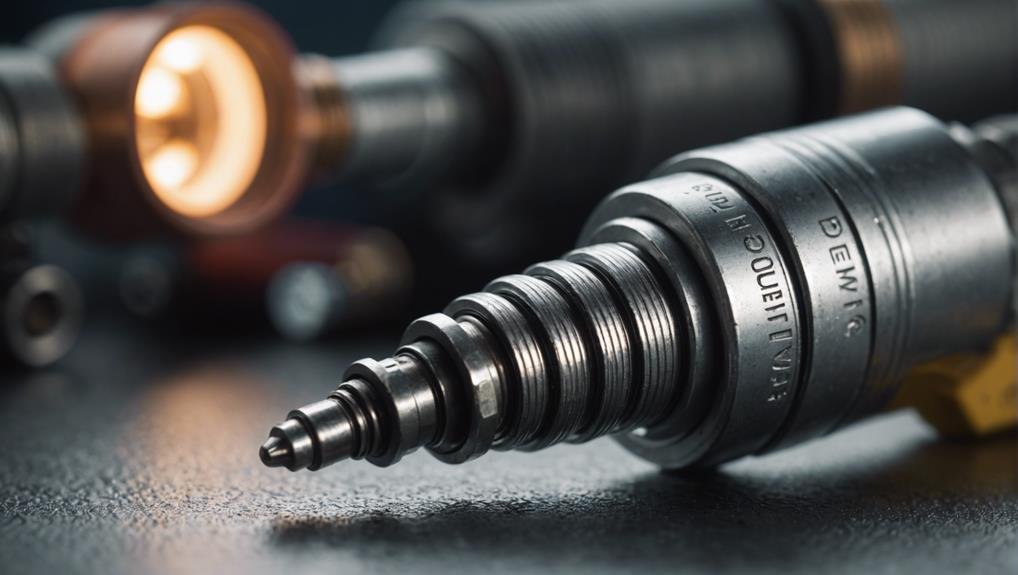When you're investigating engine issues, a spark plug diagram is more than just a visual representation – it's a valuable tool. By understanding the components, including electrodes, insulators, and metal housing, you can identify issues like rich fuel mixtures, coolant leaks, and worn valve seals. Spark plug conditions, deposits, and color codes reveal engine health and potential problems. Analyzing spark plug diagrams helps diagnose engine issues, and identifying wear patterns and deposits provides insight into combustion efficiency, fuel mixture, and general engine performance. As you delve into spark plug diagrams further, you'll uncover more about your engine's inner workings.
Key Takeaways
- A spark plug diagram illustrates critical components, including electrodes, insulator, and metal housing, which work together to create spark and dissipate heat.
- The center electrode conducts electricity to create spark, while the ground electrode dissipates heat from combustion, and the insulator maintains temperature control.
- The spark plug's color, texture, and deposits provide insights into engine health, with black deposits indicating a rich fuel mixture and spotlessly clean plugs suggesting coolant leakage.
- A spark plug's wear patterns can reveal engine performance, with rounded electrodes and light tan color indicating proper function, and excessive wear suggesting a lean air-fuel mixture.
- Analyzing spark plug color codes helps diagnose engine problems, with light brown or gray signifying ideal operation, and white or bluish deposits indicating oil or coolant leaks.
Spark Plug Diagram Basics
As you investigate the world of spark plugs, understanding the fundamental components and their relationships is important, and a spark plug diagram provides a visual representation of these critical elements.
A spark plug consists of several key components, including electrodes, a ceramic insulator, and a metal housing, which work together to ignite the air-fuel mixture in the engine cylinder.
The center electrode, an important component, conducts electricity to create a spark, while the ground electrode helps dissipate heat from the combustion process.
The insulator prevents electricity from leaking out of the spark plug and maintains proper temperature control. Having a clear understanding of these components and their relationships is necessary for diagnosing engine issues and ensuring top performance.
When analyzing a spark plug diagram, you'll notice how these components are carefully designed to work together, much like how proper wheel alignment is crucial for a vehicle's overall performance.
Reading Spark Plug Conditions
By analyzing the spark plug's condition, you can uncover valuable information about your engine's health, and a thorough understanding of spark plug diagrams, as discussed earlier, provides a solid foundation for interpreting these conditions. The color, texture, and deposits on spark plugs provide valuable insights into the engine's health and potential issues that need attention.
| Spark Plug Condition | Possible Engine Issue |
|---|---|
| Black, dry deposits | Rich fuel mixture, potentially from a problem with the air-fuel ratio |
| Spotlessly clean | Coolant leak into the combustion chamber, leading to engine cooling system issues |
| Evenly worn electrodes, no deposits | Normal wear for a properly functioning engine |
| Dry, sandy deposits | Worn valve seals or guides, affecting engine performance |
When examining your spark plugs, look for these signs to diagnose potential engine problems. A normal spark plug will have evenly worn electrodes with no deposits, indicating a properly functioning engine. However, abnormalities in the spark plug's condition can signal issues with the air-fuel ratio, engine cooling system, or valve seals and guides. By recognizing these signs, you can take corrective action to prevent further engine damage.
Common Spark Plug Deposits

You'll often encounter different deposits on your spark plug, each telling a unique story about your engine's health and performance. These deposits can provide valuable insights into what's going on under the hood.
For instance, if you notice black, dry deposits on your spark plug, it may indicate a rich fuel mixture, possibly due to a faulty fuel injector. On the other hand, spotlessly clean spark plugs can be a sign of coolant leakage into the combustion chamber.
Dry, sandy deposits can be a sign of worn valve seals or guides. Conversely, evenly worn electrodes with no deposits often indicate a normal combustion process. By examining the type of deposits on your spark plug, you can gain a better understanding of your engine's condition and identify potential issues before they become major problems.
Identifying Engine Problems
Spark plug analysis is a valuable diagnostic tool that helps you identify engine problems, such as faulty fuel injectors, coolant leaks, or worn valve seals, by examining electrode wear and deposits. By reading spark plug conditions, you can diagnose fuel injector leaks, fuel control problems, or internal engine repairs. Regular spark plug reading provides insights into engine condition, enabling timely maintenance to guarantee peak performance.
Normal wear patterns on spark plugs with high mileage can serve as indicators of engine health. However, deposits on spark plugs can indicate specific engine issues. For instance:
| Deposit Type | Engine Problem |
|---|---|
| White or light gray | Rich mixture or coolant leakage |
| Black or sooty | Fuel control problems or worn piston rings |
| Brown or rust-colored | Coolant leakage or worn valve seals |
Spark Plug Color Codes

Your spark plug's color code can be a window into your engine's general well-being, revealing important information about its running condition and performance.
The color of your spark plug can indicate whether your engine is running efficiently or if there's a problem that needs attention. A light brown or gray color on the spark plug is a positive sign, indicating ideal engine operation.
However, if you notice dark or black deposits on the spark plug, it may suggest issues with fuel combustion, such as rich fuel mixtures or poor ignition. On the other hand, white or bluish deposits can signal oil or coolant leaks into the combustion chamber.
Reading spark plug color codes is necessary for diagnosing engine problems and maintaining performance. By analyzing the color code, you can identify potential issues before they become major problems, saving you time and money in the long run.
Spark Plug Wear Patterns
As you examine your spark plug, the wear patterns on the electrode and insulator can reveal valuable information about your engine's performance. A vital wear pattern typically features a rounded electrode and a light tan color on the insulator.
However, if you notice excessive wear on the electrode, it may indicate a lean air-fuel mixture or advanced ignition timing. Furthermore, oil fouling, which appears as a black, oily deposit, can be a sign of worn piston rings or valve seals.
On the other hand, carbon fouling, characterized by black, sooty deposits, may suggest a rich air-fuel mixture or incomplete combustion. Understanding these wear patterns is essential in diagnosing engine issues and optimizing performance.
Engine Performance Indicators

By examining your spark plug, you can uncover clues about your engine's performance, including signs of a rich fuel mixture, coolant leakage, or faulty valve seals. Spark plugs can reveal valuable information about your engine's health, helping you identify potential issues before they become major problems.
Here's a breakdown of what your spark plug can tell you about your engine's performance:
| Spark Plug Condition | Engine Performance Indicator | Possible Cause |
|---|---|---|
| Black, dry deposits | Rich fuel mixture | Improper air-fuel ratio |
| Spotlessly clean | Coolant leakage | Cracked head or engine block |
| Evenly worn electrodes | Normal engine operation | Proper combustion |
| Dry, sandy deposits | Faulty valve seals | Worn or damaged valve seals |
| Wet, oily deposits | Excessive oil consumption | Worn piston rings or cylinder walls |
Troubleshooting With Spark Plugs
When troubleshooting engine issues, examining spark plugs can help you pinpoint the root cause of the problem, saving you time and money in the long run. By analyzing the spark plug's condition, you can identify potential engine performance issues.
The color of the spark plug, for instance, can indicate engine performance problems. A light brown or grayish color usually indicates a well-functioning engine, while a dark brown or black color may signal rich fuel mixtures. Deposits on the spark plug can also reveal fuel mixture problems.
If you notice excessive carbon buildup, it may indicate a rich fuel mixture, while a lean fuel mixture might leave behind a dry, white residue. By examining the spark plug's condition, you can diagnose engine health issues, such as misfires, rough idling, or decreased fuel efficiency.
Regular spark plug inspections are essential for efficient engine function, and can help prevent costly repairs down the line.
Frequently Asked Questions
How Do You Visually Tell if a Spark Plug Is Bad?
You can visually identify a bad spark plug by looking for signs like cracked porcelain, eroded electrodes, rusty threads, or soot/carbon deposits, which indicate worn, damaged, or fouled conditions that need replacement.
Can You Visually Inspect Spark Plugs?
You can visually inspect spark plugs to identify signs of wear, contamination, or damage, and by doing so, you'll be able to detect potential engine issues before they become major problems.
What Color Are Bad Spark Plugs?
'You'll typically find bad spark plugs are black, oily, or covered in dry, sandy deposits, indicating rich mixtures, coolant leaks, or worn-out electrodes – all signs that it's time to replace them to guarantee your engine runs smoothly.'
What Are My Spark Plugs Telling Me?
You're wondering what your spark plugs are telling you. By examining their color, wear, and condition, you can identify potential engine issues, such as misfires, overheating, or fuel mixture problems, and take corrective action to prevent damage.
Conclusion
You've now gained a thorough understanding of spark plug diagrams, enabling you to decipher the secrets hidden within those tiny ceramic cylinders.
By analyzing spark plug conditions, deposits, and wear patterns, you can uncover engine problems, identify performance indicators, and troubleshoot issues.
With this knowledge, you're equipped to take your DIY skills to the next level, saving time and money on repairs, and ensuring your vehicle runs smoothly and efficiently.
